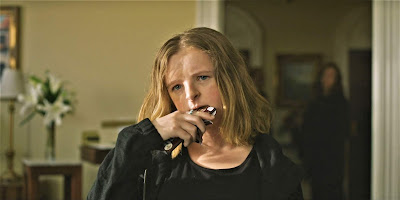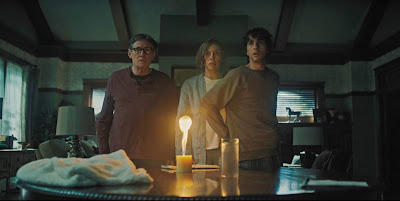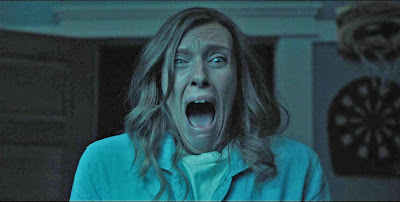Independent of what one might ultimately come to feel about Return from the Ashes after seeing it, no one can say it isn’t a bargain. Helmed by Oscar-nominated director J. Lee Thompson (The Guns of Navarone -1962, Cape Fear - 1962, The Reincarnation of Peter Proud - 1975) and written by Julius Epstein (Oscar-nominated co-writer of Casablanca - 1942), the stylish and undeniably entertaining Return from the Ashes gives you three movies for the price of one: 1) A drama about a Holocaust survivor readjusting to society after 5-years internment in a concentration camp; 2) A deception melodrama with a couple persuading a lookalike stranger to impersonate a deceased relative in order to claim an inheritance; and 3) A romantic crime thriller involving a love triangle, a fortune in money, and a complex murder plot…complete with double-crosses.
Shot in atmospheric, close-up intensive, high-contrast B&W by veteran British cinematographer Christopher Challis (Two for the Road – 1967, Evil Under the Sun - 1982), Return from the Ashes drips noirish élan and mystery from every frame. And why shouldn’t it? Its delicious mélange of a plot is essentially A Woman’s Face meets Mildred Pierce meets Vertigo meets Anastasia meets Diabolique meets The Postman Always Rings Twice.
 |
| Ingrid Thulin as Dr. Michelle Wolf |
 |
| Maximillian Schell as Stanislaus Pilgrin |
 |
| Samantha Eggar as Fabienne Wolf |
 |
| Herbert Lom as Dr. Charles Bovard |
A gripping pre-credits sequence establishes the place and time as postwar France, 1945 (make sure to drink it all in, for it’s the first and last instance of the film making any kind of serious attempt to accurately depict the era) while simultaneously setting the tone for what will be the film’s dark exploration of moral relativism, solipsism and survival, and the ways in which our experiences shape who we become.
On a train traveling from Germany to France, a child in a crowded compartment is making a nuisance of himself by repeatedly kicking an exit door and fiddling with its latch (Mother: “[pleadingly] If I give you another bar of chocolate, will you stop then?” child: “[kicking intensifying] Perhaps”). When tragedy strikes in the form of the door giving way and launching das schrecklich kind out into the darkness, the passengers all react with appropriate shock and horror. All but one.
The individual closest to the now-yawning chasm that claimed the little brat…er, boy, is a gaunt, graying woman whose face bears a scar, upon whose wrist are the tattooed numbers of a death camp, and whose haunted eyes stare without seeing…a past witness to horrors far worse.
The Holocaust survivor and titular Phoenix returning from the ashes of Dachau is Dr. Michelle Wolf, a Jewish radiologist en route to Paris in hopes of reclaiming her earlier life. Presuming, of course, that there’s still a life to reclaim, for everyone who knew her now presumes she is dead.
She's gone but not forgotten by confidant and medical colleague Dr. Charles Bovard (Lom), a plastic surgeon whose feelings for Michelle run deeper than friendship. She's recalled (less than fondly) but not missed by the rancorous Fabienne “Fabi” Wolf (Eggar), Michelle’s estranged, neglected step-daughter from an earlier, widowed marriage. And she's unmourned but thought of with gratitude by her handsome, penniless younger husband, Stanislaus “Stan” Pilgrin (Schell), freelance chess master and master freebooter who wed Michelle mere moments before she was seized by the Gestapo (suspicious, that), granting the otherwise homeless fortune-hunter legal access to Michelle’s now-vacant home.
She's gone but not forgotten by confidant and medical colleague Dr. Charles Bovard (Lom), a plastic surgeon whose feelings for Michelle run deeper than friendship. She's recalled (less than fondly) but not missed by the rancorous Fabienne “Fabi” Wolf (Eggar), Michelle’s estranged, neglected step-daughter from an earlier, widowed marriage. And she's unmourned but thought of with gratitude by her handsome, penniless younger husband, Stanislaus “Stan” Pilgrin (Schell), freelance chess master and master freebooter who wed Michelle mere moments before she was seized by the Gestapo (suspicious, that), granting the otherwise homeless fortune-hunter legal access to Michelle’s now-vacant home.
Well, not vacant for long.
Out of shared grief (not), Stan and Fabi take up residence as lustful cohabitants driven mad with frustration by a law prohibiting them from collecting on three hundred million francs bequeathed to the presumed-to-be-dead Michelle due to the absence of an identifiable corpse.
Michelle’s return from the ashes may not be swift—transformed internally by her ordeals in Dachau, she waits until she can be transformed externally by plastic surgery to restore her former beauty—but when it happens it is most definitely seismic. With scores to settle and amends to make, Michelle’s return sets into motion the labyrinthine machinations and stratagems outlined earlier. Schemes Stan himself describes as “Bizarre, grotesque…” leading Michelle to feel “Revolted, curious, shocked, even thrilled…all at the same time.”
Which just so happens to be exactly what some critics felt about Return From the Ashes in 1965.
 |
| You Had One Eye in the Mirror |
A problem I once had with the glut of sound-alike, ersatz film-noir erotic thrillers that sprang up like weeds in the ‘90s in the wake of Body Heat, Fatal Attraction, and Basic Instinct, is that they always seemed to happen in a kind of void; never occupying a recognizable world nor appearing to be tethered to anything other than the absurd, gimmicky requirements of the genre.
Return From the Ashes is just as convoluted and far-fetched as those erotic thrillers, but for some reason, it works so effectively for me and never feels as contrived as perhaps it should. Maybe this is because one accepts a certain level of artifice with older films, or maybe it's due to the fact that everything about the film's construction—from its visual style to its setting to its characters—is indeed arch, but of a thematic whole. The characters and the world they inhabit appear to be an extension of one another.
Chess, the activity that brings the two lead characters together, is used as both metaphor and symbol.
 |
| "You have the advantage." |
 |
| "If there is no God, no immortality, no heaven, no hell, no reward, no punishment...then everything is permissible." |
Return From the Ashes is a melodrama that utilizes the stark contrast of black and white to tell a story of stark evil and moral relativity. Set in the era of WW2 and German-occupied France, the sociological fallout of Hitler's dominance forces the collision of ethical principles and survival instincts. In a world where clear-cut distinctions between right and wrong have been blurred and minimized, the film asks us to look at its dissolute characters not solely as individuals inherently good or bad, or even victims; but as individuals imbued with free will who are shaped, scarred, and perhaps reclaimed by their circumstances.
THE STUFF OF DREAMS
Return From the Ashes takes place roughly between the years 1938 and 1947 (just how much time transpires between Michelle's release from Dachau and eventual return to her former life is rather murkily conveyed), but the film is almost hilariously disinterested in making any of the lead characters look remotely period-appropriate. Michelle's lacquered flip hairstyle and pale lipstick recall Sixties-era Dina Merrill; Fabi's long, flowing locks are pure Carnaby Street Jean Shrimpton: and Stan walks around with a traditional pomaded '60s Rat Pack cut that makes him look like John Cassavetes in Rosemary's Baby.
Although the practice of setting a film in the past while wholesale ignoring historical accuracy in everything but automobiles and dress extras is very common in sixties films, it still plays havoc with one's suspension of disbelief and the ability to lose oneself in the narrative. I found I had to keep reminding myself at crucial points just when all this was supposed to be taking place.
 |
| Let's Do The Time Warp Again SS agents from 1940 confront a stylish couple from 1964. This reminds me of that musical number in Xanadu where the '40s blend awkwardly with the '80s. |
PERFORMANCES
With the characters in Return From the Ashes all fairly morally repugnant, it serves as no small compensation that they are all at least so strikingly beautiful. I’ve always liked Ingrid Thulin, an actress possessing an intelligent beauty that conveys both self-assured dignity and vulnerability. Her Michelle Wolf is a surprisingly modern character, written in a dimensional manner that allows her to be independent, smart, selfish and self-possessed, weak, willful, and ultimately empathetic.
Return From the Ashes was released four months after Samantha Eggar made her star-making (and Oscar-nominated) appearance in William Wyler's The Collector. As the delightfully devious and unhinged Fabienne Wolf, Eggar is all petulant malice and emotional greed. She makes for a dangerously unhinged romantic rival while managing to bring a pitiably wounded quality to her character's rigid self-defensiveness.
In the key role as the unapologetic cad so charming that two women are willing to overlook his black heart and shameless narcissism, Oscar-winner Maximillian Schell (Judgement at Nuremberg - 1961) gives an assured, witty, and utterly fascinating performance.
Capturing all the ambiguity the role embodies, his Stanislaus is a real charmer who is never all villain, never all hero, and always maddeningly hard to read...though the always-welcome Herbert Lom has Stan's number from the start and never passes up an opportunity to let us know.)
 |
| Vladek Sheybal as Paul, the chess club manager Familiar from several Ken Russell films, Vladek Sheybal, portrayed chess master Tov Kronsteen in the Bond film From Russia, With Love (1963) |
THE STUFF OF FANTASY
Return From the Ashes wasn’t a success when released, and I suspect it disappeared from theaters rather quickly. It most certainly seems to have disappeared from people's minds. Studios tend to bury underperforming films when it comes to TV broadcasts, and Return From the Ashes bore the double burden of having been marketed as a film for adults, so perhaps that's why I have no memory of it cropping up on The Late Late Show when I was a kid. I don't even know if it ever even had a home video release.
I do, however, remember being scared out of my wits by the TV ad that ran when it opened in theaters in 1965. YouTube reveals it wasn't all that explicit, but I was only about 8-years-old or so at the time and distinctly remember hearing the sinister-sounding title and leaping to the conclusion that it must be a ghost story or vampire movie. All other details had previously remained vague save for the kindertrauma warning "No one may enter the theater after Fabi enters her bath!" and a shot of a shadowy figure opening a bathroom door. Yikes!
Taking a page from the William Castle promotion playbook while drawing intentional parallels to both Hitchcock's Psycho (1960) and Clouzot's 1955 film Diabolique (Clouzot initially owned the rights to the 1961 novel upon which this film is based Le Retour des Cendres by Hubert Monteilhet) Return From the Ashes was misleadingly marketed as a shocker. Moviegoers expecting edge-of-your-seat thrills and a Samantha Eggar bubble bath equivalent of Janet Leigh's shower must have felt duped when served a somber crime drama instead.
Taking a page from the William Castle promotion playbook while drawing intentional parallels to both Hitchcock's Psycho (1960) and Clouzot's 1955 film Diabolique (Clouzot initially owned the rights to the 1961 novel upon which this film is based Le Retour des Cendres by Hubert Monteilhet) Return From the Ashes was misleadingly marketed as a shocker. Moviegoers expecting edge-of-your-seat thrills and a Samantha Eggar bubble bath equivalent of Janet Leigh's shower must have felt duped when served a somber crime drama instead.
In spite of my fearful awareness of the film as a child (between this and Psycho, the family bathroom became a chamber of horrors for me...I have no idea how my mother ever got me to bathe at all), I didn't get around to actually seeing Return From the Ashes until it became available through made-to-order DVD around 2011. But even now it's rare that I come across someone anyone familiar with the title, rarer still to meet someone who's seen it.
BONUS MATERIAL
Hubert Monteilhet's novel makes for only the first third of the film adaptation. Many of the film's most sensational elements are the invention of screenwriter Julius Epstein. If you're interested in how the film deviates from its source novel, check out a breakdown of the novel HERE, where you'll also find information on a 2015 feature film remake/adaptation titled Phoenix.
A year after appearing in Return From the Ashes, actress/model Talitha Pol wed John Paul Getty Jr. and the pair became major style icons of the hippie-chic jet-set '60s. The color pic is from a 1969 Vogue photoshoot of the hard-partying couple by Patrick Lichfield. Pol died of a heroin overdose in 1971.
Samantha Eggar and Maximillian Schell in a clip from "Return from the Ashes" (1965)
 |
| Talitha Pol as Claudine |
Copyright © Ken Anderson 2009 - 2019










































